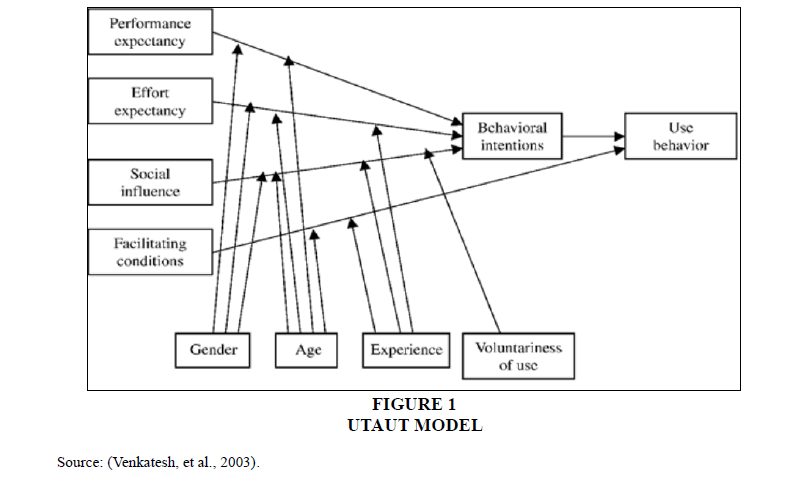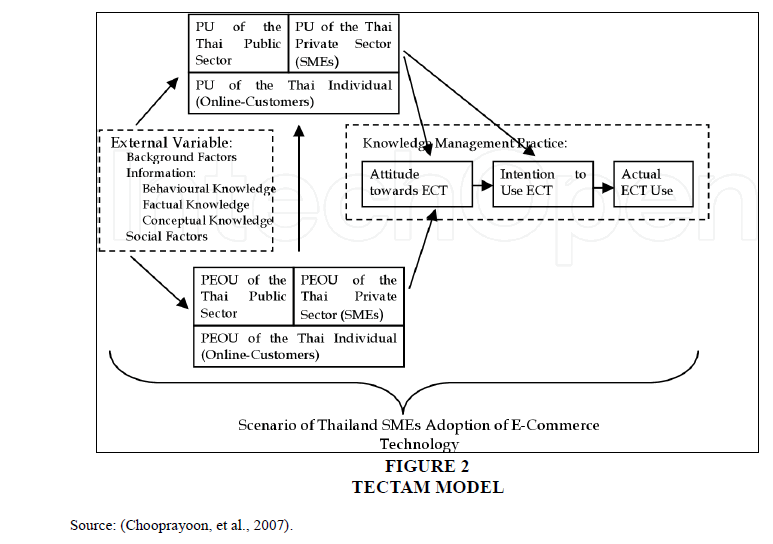Review Article: 2024 Vol: 28 Issue: 1
A Review of Adoption Theories on Technology Acquisition in Indian SMEs
Anuj Kumar, Apeejay School of Management, Delhi
Anoop Pandey, HNB Garhwal University, Pauri, Uttarakhand
Monika Arora, Amity University, Gurugram
Purvi Pujari, VPSM, DY Patil University, Navi Mumbai
Citation Information: Kumar, A., Pandey, A., Arora, M., & Pujari, P. (2024). A review of adoption theories on technology acquisition in indian smes. Academy of Marketing Studies Journal, 28(1), 1-5.
Abstract
Technology acquisition is important for the small and medium enterprises in India because technology is the future. During COVID pandemic many small and medium organizations have realized the importance of technology acquisition. In Developed countries, the technology acquisition is at advanced stage and more structured in comparison to India. There are several factors which affect technology acquisition. In this research paper, the researchers will do an analysis of various theories for the purpose of technology acquisition in Indian environment. The results analyzed in developed countries can’t be generalized in Indian environment. The researchers will do a literature analysis of various theories responsible for technology acquisition and try to analyze the factors responsible for the technology acquisition.
Keywords
Technology acquisition, India, TTF, SMEs, Adoption.
Acknowledgement
This research work has been done under the Major Research Project Grant titled "Strategic Technology Adoption and Acquisition: A Review of Policy Intervention and Impact on Performance of SMEs in India" sponsored by IMPRESS ICSSR (Govt. of India) in 2021-22.
Introduction
The consumers demand is changing constantly, and competition is also growing from multinational national organizations. Not only big multinational but also small SMEs need to maintain the changing pace to survive in disruption phase of technology. There are many theories which discussed about technology acquisition and adoption. In this paper, the researcher will focus on review of few of such theories.
Literature Review
At present, the most discussed model for technology adoption and acquisition is UTAUT model. UTAUT model was proposal by Vankatesh, Davis and Morris. This model is based on four major key constructs. All the SMEs want to improve their performance over a period and the first construct of UTAUT model relates to the performance of the SMEs. Performance expectancy reflects how acquisition of technology will enhance the performance of small firms. The second construct of technology is effort expectancy. The beauty of UTAUT theory lies in its capability to study the adoption of technology at individual level. Effort expectancy analyze how easy is to use technology at individual level to discuss the ease associated with it. Venkatesh et al. (2003) discussed about ease of use while using technology. The use of technology is mandatory for small and medium firms now a days. The third construct of UTAUT theory focuses on peer pressure or social pressure related to the acquisition of technology in SMEs. Social Influence is the third construct which discusses about societal influence. The acquisition and adoption of technology also depends upon the type of infrastructure available in the firms and will that infrastructure sufficient for the firms. The fourth construct of the model is named as facilitating conditions. It judges the technological infrastructure of the company and its usage in technology adoption. All these four constructs are independent factors and behavioral intention is the dependent factor. Behavioral intention talks about the individual readiness to perform a specific type of behavior. How much the individual is ready? The individual factors which are part of UTAUT model are age, gender, experience and voluntarily use of the technology. These factors are moderating the constructs. The researchers are using this model to study about adoption of various types of technology 2.0, technology 3.0 and technology 4.0 components. An extension of UTAUT model is UTAUT 2 theory. The UTAUT2 theory talks about the additional constructs of UTAUT model (Venkatesh, et al., 2012). One of such extension was hedonic motivation, in which the authors were discussing how much technology usage is enjoyable by the individual users. One also needs to understand the price value in UTAUT2 model. The price value talks about the benefits of using technology and what is the cost associated with usage of technology. Habit is also an additional component of UTAUT theory which talks about since how long individuals were using the technology.
Khazaei (2020) argued about the adoption of block chain technology using UTAUT model. The authors discussed adoption from the perspective of Malaysian SMEs. Misra et al. (2022) also argued about the adoption of e commerce for both buyers as well as sellers. They have studied the e commerce adoption in tier II/III cities of India by implementing the UTAUT model. They also tried to find out the challenges in adoption of technology. Dutta & Shivani (2020) discussed about e commerce revolution. The authors discussed about e commerce adoption in Indian SMEs considering the perspective of women entrepreneurs. They have studied the UTAUT2 model for adoption and acquisition of e commerce. Chatterjee & Kar (2020) also tried to identify the reasons behind social media tools adoption in SMEs and how those social media tools are beneficial for small and medium organization. The authors have studied the adoption with the usage of UTAUT model/ theory. Kumar and Ayedee (2021) has also discussed about technology adoption in SMEs during COVID 19 phase. Basically, during COVID 19 phase, the SMEs owners showed more urgency towards technology adoption because there was not other way to come out of the challenges Figure 1.
Figure 1: Utaut Model.
Source: (Venkatesh, et al., 2003).
A series of theories and models have discussed about technology acquisition and adoption. TECTAM theory/model has been seen as a combination of Theory of Reasoned Action, Technology Acceptance Model, Theory of Planned Behavior and UTAUT theory. Chooprayoon et al. (2007) discussed about technology adoption through TECTAM model. The components of TECTAM model includes. The two important components of TECTAM model are perceived use and perceived ease of use. The researchers have segregated perceived use into perceived use of public sector, private sector and individual customers, similarly perceived ease of use of public sector, private sector, and individual customers. The model also includes external variables which consist of personal factors; social factors and information consist of behavioral, conceptual, and factual knowledge. The main things which carry the base of the model are attitude of the users towards adoption, whether they are positive towards usage of technology or not, secondly the intent to use the technology and the actual usage of technology Figure 2.
Figure 2: Tectam Model.
Source: (Chooprayoon, et al., 2007).
Another model which discussed about technology acquisition and adoption in SMEs is task technology fit. This model has discussed the perspective of the individual while doing technology acquisition. Goodhue and Thompson (1995) argued that the technology adoption depends upon the individual task. How much is the task appropriate and what leads to technology utilization? TTF model helps in knowing the degree to which technology can assist an individual in performing his/her task. Prior, TAM model was also talking about technology adoption at individual level but TTF model is also overcoming the weaknesses of TAM model. An individual is performing various tasks in the firms and those tasks also require the usage of technology. The components of TTF model are helpful in knowing what are the tasks performed by the individual and how technology is assisting in completion of those tasks. The application of technology needs to be understood at much higher and deeper level.
Findings and Discussions
The overview and analysis of all the above discussed theories summarized that adoption at individual level is must. Technology acquisition is not new and it is not a matter of choice for the organization. There are several challenges also in usage of technology but those challenges need to be overcome. An observation on several models suggests that most of the models were studying the technology adoption at individual level i.e., TAM, TTF, UTAUT, UTAUT2 etc. There is strong need to develop more models which can talk about technology adoption at firm level. Currently, TOE theory is talking about technology adoption at firm/organization level. The individual perspective evolving out in the models is good but it is not giving collective information at firm level. In India scenario is different, the adoption is missing at firm level. The small firms in India are not even matured to understand the technology acquisition of different components of technology 2.0. Today, we are discussing about technology 4.0 or technology 5.0 but firm level adoption is missing. India follows a collective culture and till the time all the employees at upper level, middle level and lower level will adopt the technology, the acquisition will not give favorable results. The review of various models also suggested that it is important to identify the actual intent of individual behind using the technology. The attitude of an individual takes him towards the technology usage but till how long he/she will be connected towards the usage of technology. The intent can only go stronger if the challenges are overcome.
Conclusion
The paper can be concluded in the positive manner that technology acquisition can help and lead Indian SMEs towards more advancement and it can bring sustainability in their outputs. If the technology acquisition operationalized in the right manner, it can bring down the overall cost in the firms. Indian SMEs are not very rich; technology can provide them a way out in performing the daily operations and saving money as well. Indian users have a positive attitude towards acquisition of technology, but that attitude is not sustaining for longer terms, it needs to be sustained than only it can give positive results.
Acknowledgement
This paper was presented in ICSSR sponsored two day International multidimensional conference on “Revisiting Wellbeing: Perspectives, Challenges and The Road Ahead” under the aegis of DU Centenary Celebration held on February 1st - 2nd 2023.
References
Chatterjee, S., & Kar, A. K. (2020). Why do small and medium enterprises use social media marketing and what is the impact: Empirical insights from India. International Journal of Information Management, 53, 102103.
Indexed at, Google Scholar, Cross Ref
Chooprayoon, V., Fung, C. C., & Depickere, A. A. (2007). TECTAM, A modified technology acceptance model to assess E-commerce technologies adoption by Thai SME. In TENCON 2007-2007 IEEE Region 10 Conference (pp. 1-4). IEEE.
Dutta, S., & Shivani, S. (2020). Modified UTAUT2 to Determine Intention and Use of E-Commerce Technology Among Micro & Small Women Entrepreneurs in Jharkhand, India. In Re-imagining Diffusion and Adoption of Information Technology and Systems: A Continuing Conversation: IFIP WG 8.6 International Conference on Transfer and Diffusion of IT, TDIT 2020, Tiruchirappalli, India, December 18–19, 2020, Proceedings, Part II (pp. 688-701). Springer International Publishing.
Goodhue, D. L., & Thompson, R. L. (1995). Task-technology fit and individual performance. MIS quarterly, 213-236.
Khazaei, H. (2020). Integrating cognitive antecedents to UTAUT model to explain adoption of blockchain technology among Malaysian SMEs. JOIV: International Journal on Informatics Visualization, 4(2), 85-90.
Indexed at, Google Scholar, Cross Ref
Kumar, M. A., & Ayedee, D. N. (2021). Technology Adoption: A Solution for SMEs to overcome problems during COVID-19. Forthcoming, Academy of Marketing Studies Journal, 25(1).
Misra, R., Mahajan, R., Singh, N., Khorana, S., & Rana, N. P. (2022). Factors impacting behavioural intentions to adopt the electronic marketplace: findings from small businesses in India. Electronic Markets, 32(3), 1639-1660.
Indexed at, Google Scholar, Cross Ref
Venkatesh, V., Morris, M. G., Davis, G. B., & Davis, F. D. (2003). User acceptance of information technology: Toward a unified view. MIS quarterly, 425-478.
Venkatesh, V., Thong, J. Y., & Xu, X. (2012). Consumer acceptance and use of information technology: extending the unified theory of acceptance and use of technology. MIS quarterly, 157-178.
Received: 03 Jul 2023, Manuscript No. AMSJ 23 13754; Editor assigned: 04 Jul 2023, PreQC No. AMSJ 23 13754(PQ); Reviewed: 26 Sep 2023, QC No. AMSJ 23 13754; Revised: 03 Oct 2023, Manuscript No. AMSJ 23 13754(R); Published: 24 Nov 2023

